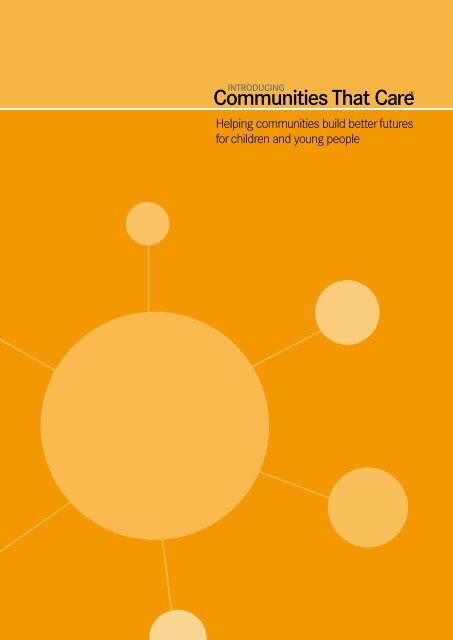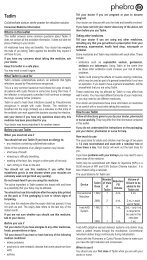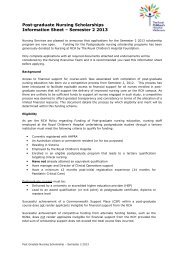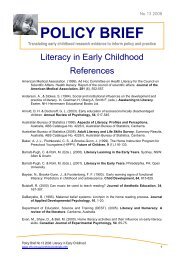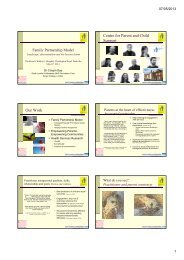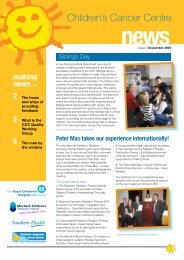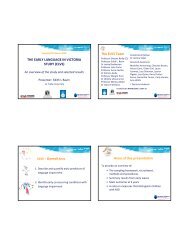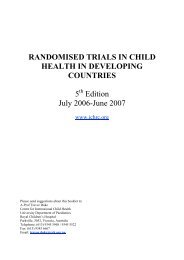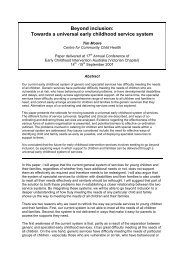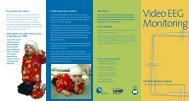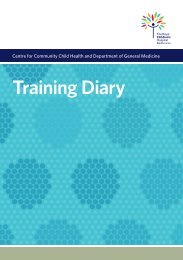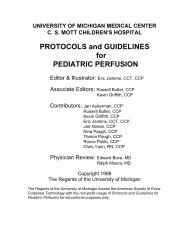Introducing Communities That Care (Australia)
Introducing Communities That Care (Australia)
Introducing Communities That Care (Australia)
You also want an ePaper? Increase the reach of your titles
YUMPU automatically turns print PDFs into web optimized ePapers that Google loves.
<strong>Introducing</strong>®<strong>Communities</strong> <strong>That</strong> <strong>Care</strong>Helping communities build better futuresfor children and young people
Authors: Sandy Cahir, Liz Davies, Paul Deany,Cecily Tange, John Toumbourou, Joanne Williams,Raelene RosickaPublished by <strong>Communities</strong> <strong>That</strong> <strong>Care</strong> ® Ltd.,C/O The Centre for Adolescent Health,2 Gatehouse Street, Parkville, Victoria 3052Phone: (03) 9345 5890Fax: (03) 9345 6502Web: www.rch.org.au/cah© <strong>Communities</strong> <strong>That</strong> <strong>Care</strong> ® Ltd.,2003This work is copyright. Apart from any use aspermitted under the Copyright Act 1968,no part may be reproduced by any processwithout written permission from <strong>Communities</strong><strong>That</strong> <strong>Care</strong> ® Ltd.<strong>Communities</strong> <strong>That</strong> <strong>Care</strong> ® is a registered trademarkand service mark of Channing Bete Company, Inc.ISBN: 1 74056 007 8
<strong>Introducing</strong><strong>Communities</strong>®<strong>That</strong> <strong>Care</strong>Table of contentsPreface 2<strong>Communities</strong> <strong>That</strong> <strong>Care</strong> ® in Your Community: An Overview 3Introduction 4How to use this material 4The <strong>Communities</strong> <strong>That</strong> <strong>Care</strong> ® Conceptual Framework 5Background and Rationale 6Research foundation 61. The Social Development Strategy 62. A comprehensive community-wide approach 83. Evidence-based predictors of risk and protective factors 8Descriptions of risk and protective factors 124. Effective, tested policies, programs and practices 16Implementation 17The five-phase process of implementation 18
PrefaceOriginating in the United States of America,the <strong>Communities</strong> <strong>That</strong> <strong>Care</strong> ® (CTC) process hasbeen adapted for use in <strong>Australia</strong> by <strong>Communities</strong><strong>That</strong> <strong>Care</strong> ® Ltd. (<strong>Australia</strong>). <strong>Communities</strong> <strong>That</strong> <strong>Care</strong> ® Ltd.is the sole licensed provider of the CTC process in<strong>Australia</strong>. It is a non-profit company set up under a jointinitiative of the Women’s and Children’s Health Network,and the Rotary Club of Melbourne. Since 2000 the workof CTC Ltd. in <strong>Australia</strong> has been financially supportedby the Rotary Club of Melbourne, the Victorian HealthPromotion Foundation (Vic Health), and a numberof philanthropic organisations.<strong>Communities</strong> <strong>That</strong> <strong>Care</strong> ® was developed in the USAby Professor J David Hawkins and Professor RichardF Catalano, at the University of Washington, Seattle.In America, CTC, provided by the Prevention ScienceGroup of Channing Bete Company, has been implementedin over 500 communities. The experienceof CTC in America has resulted in increased localinvestment in prevention, and the improvedunderstanding of prevention. <strong>Communities</strong> <strong>That</strong><strong>Care</strong> ® is now operating in the United Kingdom,the Netherlands and <strong>Australia</strong>.Since 2000 three communities have implemented<strong>Communities</strong> <strong>That</strong> <strong>Care</strong> ® Ltd. pilots in <strong>Australia</strong> –Bunbury (Western <strong>Australia</strong>), Mornington Peninsulaand Ballarat (both in Victoria). The Centre for AdolescentHealth has supported the early establishment stagesof the CTC implementation process in thesecommunities. Planning is underway to involvea number of new communities throughout <strong>Australia</strong>.The <strong>Australia</strong>n work of <strong>Communities</strong> <strong>That</strong> <strong>Care</strong> ® Ltd. isdirected by the <strong>Communities</strong> <strong>That</strong> <strong>Care</strong> ® Ltd. Board, withmembership from both the Rotary Club of Melbourneand the Women’s & Children’s Health Network.2<strong>Introducing</strong> <strong>Communities</strong> <strong>That</strong> <strong>Care</strong> ®
<strong>Communities</strong> <strong>That</strong> <strong>Care</strong> ® in yourcommunity: An OverviewCTC visionTo promote the healthy development of children and youngpeople, and to prevent health and social problems by addressingthe factors that increase the likelihood of positive developmentand decrease the likelihood of adverse outcomes for childrenand young people.Guiding principlesCTC:• is based on rigorous research from fields includingpublic health, sociology, psychology, education,criminology, medicine and organisational development• is informed by a social development model• is adaptable to the needs of different and distinctcommunities• engages all areas of the community• empowers communities to build prevention capacity.Implementation processFacilitate the way a community promotes the healthydevelopment of children and young people.Identify and address priority areas to promote healthydevelopment before young people become involvedin problem behaviours.Enable communities to use their unique data-based profileto craft a comprehensive, long-range plan for strengtheningexisting resources and filling identified gaps to promote healthydevelopment of children and young people.OutcomeHealthy development of children and young people.©<strong>Communities</strong> <strong>That</strong> <strong>Care</strong> ® Ltd (<strong>Australia</strong>) 2003 3
Introduction<strong>Communities</strong> <strong>That</strong> <strong>Care</strong> ® (CTC) is the application,in communities, of research-based prevention sciencefor the healthy development of children and young people.This is achieved by bringing together a diverse range of people,programs and initiatives to promote the community-wideCTC process. The CTC process is a long-term, comprehensive,risk and protective-focussed prevention strategy basedon research of predictors of health and behaviour problems.By using an early intervention and prevention framework,communities are guided towards understanding their local,identified needs, then refining, and/or developing andimplementing tested, effective strategies to address thoseneeds. In particular, in the <strong>Australia</strong>n context, the CTC processprovides an integrated approach to the prevention of problembehaviours, including harmful substance use, low academicachievement, early school leaving, sexual risk-taking,and violence.In the early phase of implementing the CTC process, keycommunity leaders are identified. Key Leaders are thosein the community who hold existing recognised positionsof responsibility and influence in individual communities. Thesepeople are those who know the community well and are ableto influence policy and organisational change, are in a positionto develop community collaborations, and are able to directresources. Key Leaders are responsible for initiating communityengagement that involves all sectors of the communityin the strategy.A Community Board is then established, comprisinga group of interested members of the community, who workwith the Key Leaders to analyse the unique needs of thecommunity, and to plan and implement tested, effectiveprograms to foster the healthy development of children andyoung people. In concert with the Key Leaders, the CommunityBoard is a decision-making body representing a rangeof organisations, community members and young people.Its members come from a diversity of backgrounds andinterests, have a commitment to fostering healthy developmentfor children and young people, and, importantly, have a capacityto be involved. The training and support provided by CTC Ltd.guides the Community Board towards determining local needs,and implementing appropriate evaluated interventionstrategies that lead to safer, more supportive communitiesfor children and young people.In the planning and implementation process undertakenby your community, <strong>Communities</strong> <strong>That</strong> <strong>Care</strong> ® Ltd. will provide:• a five-phase process of stages and steps• strategic consultation• training• technical assistance• administration, analysis and reporting of the CTC YoungPeople’s Health and Wellbeing Survey*• a Prevention Strategies Guide.* The survey is used as a data-measuring tool to providecommunity specific data on young people’s involvement in healthcompromising behaviours, and the prevalence of risk and protectivefactors that predict these behaviours. It is recommended that theYoung People’s Health and Wellbeing Survey be completed every2-3 years to chart progress of outcomes targeted during the CTCplanning and implementation process. Doing so enables theCommunity Board to monitor effectiveness of policies, programsand practices implemented, and to determine necessarynew initiatives.How to use this materialThis material is designed to provide an introduction to the<strong>Communities</strong> <strong>That</strong> <strong>Care</strong> ® Ltd. process. It provides communitieswith the background information necessary for a preliminaryunderstanding of the process that enables the initiationof healthy development and local prevention planning forchildren and young people. <strong>Introducing</strong> <strong>Communities</strong> <strong>That</strong><strong>Care</strong> ® is followed by <strong>Communities</strong> <strong>That</strong> <strong>Care</strong> ® : Guidelinesfor Implementation that provides technical guidance throughthe phases, stages and steps of implementation.A key goal of <strong>Communities</strong> <strong>That</strong> <strong>Care</strong> ® Ltd. is to remaincurrent with prevention science in order to keep communitiesat the cutting edge. Materials are regularly revised to incorporatenew research findings, particularly in areas such as riskand protective factors, and evaluation of prevention programs.4 <strong>Introducing</strong> <strong>Communities</strong> <strong>That</strong> <strong>Care</strong> ®
The <strong>Communities</strong> <strong>That</strong> <strong>Care</strong> ® Conceptual FrameworkThis framework provides an overview of the <strong>Communities</strong> <strong>That</strong> <strong>Care</strong> ® process.Community profiling Community engagement Community action planResearch base• Social Development Strategy• Demonstrated riskand protective factors• Comprehensive community -wide approach• Public health model• Effective, tested policies,programs and practices• Evaluation and monitoringTools• Young people’s survey• Identify risk/protective factors• Resource assessment• Identify Key Leaders/Board• Capacity-building• Training• Identify strategies• Share the plan• Monitor implementationFocus areasSchool Community Family Peer/IndividualIncrease in protective factorsDecrease in risk factorsHealthy developmentof children and young people©<strong>Communities</strong> <strong>That</strong> <strong>Care</strong> ® Ltd (<strong>Australia</strong>) 2003 5
Background and RationaleWhat is the role of <strong>Communities</strong> <strong>That</strong> <strong>Care</strong> ® ?CTC helps communities to:• engage all members of the community who havea stake in healthy futures for children and youngpeople, including elected Key Leaders, children, youngpeople, local government, parents, law enforcement,local youth and family services and organisations,schools, recreation providers, the religious, culturaland spiritual community, health, mental health, socialservices, the business community, and residents,• establish a shared vision, a common language, anda collaborative planning structure to integrate diversecommunity efforts addressing issues facing children,young people and families,• establish priorities for action based on an evidencebasedprofile of community strengths and challenges,• define clear and measurable outcomes that canbe tracked over time to show progress and ensureaccountability,• identify gaps in the current response to priorities• select tested, effective policies, programs andpractices that have demonstrated effectivenessto fill identified gaps,• evaluate progress towards desired outcomes.Research foundationOne of the hallmarks of the CTC framework is its groundingin rigorous research from a variety of disciplines. There are fourprimary areas of research that form the foundation of CTC:• The Social Development Strategy• A comprehensive, community-wide approach• Data-based predictors of risk and protective factors• Effective, tested policies, programs and practices.1. The Social Development StrategyThe Social Development Strategy is the research frameworkthat guides communities towards their vision of positive futuresfor children and young people. Based on research that hasidentified protective factors that can buffer children and youngpeople from risks, and promote their healthy development, theframework has a goal of healthy, positive behaviours for childrenand young people. Further, research indicates that thedevelopment of healthy behaviours in young people occurswhen they are immersed in environments that support:• consistent communication of healthy beliefs and clearstandards for behaviours. CTC engages all communitymembers in a dialogue about core beliefs that help childrenand young people develop into healthy, productive citizenswho avoid adverse behaviours. CTC aims to infuse thosebeliefs into every aspect of a young person’s life.• the development of strong bonds to their families,schools, communities and peer groups. Children becomemore invested in following the beliefs and standards heldby these groups. Research shows a child living in a high-riskenvironment can be protected from adverse behaviourby a strong, affectionate relationship with an adult, whocares about, and is committed to his/her healthydevelopment. The adult can be a parent, a teacher, anextended family member, a coach, an employer, or anadult from the child’s religious or spiritual community –any caring adult. The most critical aspect of this relationshipis that the child or young person has a long-term investmentin the relationship, and believes that the relationship isworth protecting. This investment motivates them to abideby the healthy beliefs and clear standards held by theseimportant adults in their lives.6 <strong>Introducing</strong> <strong>Communities</strong> <strong>That</strong> <strong>Care</strong> ®
These bonds are created by providing opportunities for youngpeople to be involved in meaningful ways, skills for successfulinvolvement, and recognition for their involvement.Strong bonds are built when children and young peoplehave opportunities to be involved in their families, schools,communities and peer groups, to make a real contribution,and to feel valued for it. In order for children and young peopleto take advantage of the opportunities provided for themin their families, schools, communities and peer groups,they need to be equipped with the skills that create successin that involvement. These skills are social skills, cognitiveskills, emotional skills, and behavioural skills. Recognisingchildren and young people’s involvement encourages themto contribute in meaningful ways, and assists them to acceptproductive feedback when necessary.Recognising individual characteristics, and acknowledgingthat each child and young person presents with a different setof skills and abilities, is important in promoting their positivedevelopment. It is important for adults connected with childrenand young people, such as community members, and healthdevelopment and prevention program personnel, to be awareof the range of skills and abilities of children and young people,and to respond accordingly. For children born without theprotective advantages of a positive social orientation, withoutcoping skills and without learning capacity, we need to havethe strategies in place to provide opportunities for involvement.All children and young people need access to social, emotional,and cognitive competency, and recognition for their efforts,as well as their successes.The Social Development Strategy below can be usedas a framework for strengthening a range of areas in thecommunity. These might include:• Individual relationships established between adults andchildren and young people. These serve as healthy rolemodels and provide opportunities and recognition forprosocial involvement.• Youth-servicing organisations and programs. These canprovide young people with opportunities for bonding andto interact with adults and prosocial peers, skills to take partsuccessfully in those opportunities, and recognition fortheir involvement.Social Development StrategyAdapted (2003) from <strong>Communities</strong> <strong>That</strong> <strong>Care</strong> ® (US) Social Development Strategy, 1998 with permission from Channing Bete Company, Inc.©<strong>Communities</strong> <strong>That</strong> <strong>Care</strong> ® Ltd (<strong>Australia</strong>) 20037
• Links between different sections of the community.This is as diverse as the family environment, shopping areas,private and public sector organisations, fitness and leisurefacilities, parks and gardens, community police, lawand policy.2. A comprehensive community-wideapproachWhy use a public health approach?Engaging all segments of the community in preventivecampaigns to educate and promote behaviour change is,today, an accepted approach in the field of public health.This approach is supported by research that has documentedthe effectiveness of a community-wide approach to publichealth issues. Health issues such as heart disease, breastcancer, and alcohol-affected driving have successfully beenaddressed in this way. Prevention of heart disease,for example, has been approached on many fronts:supermarkets and restaurants offer ‘low-fat, heart-healthy’foods; buildings, restaurants, and workplaces are smoke-free;gyms, jogging tracks, and aerobic classes are more availableand more popular; television publicity campaigns promotehealthy living; and schools include health in curricula.This comprehensive approach, adopted to multi-illnessprevention, has proven successful in altering attitudes andbehaviour where other methods have produced limited results.We can apply this same strategy to problem behavioursin children and young people.What does research tell us?Research tells us that a community-wide approach is effectivebecause it:• affects the entire social environment. The focus is oninfluencing norms, values and policies that promote a safeand healthy community, as well as changing the conditionsthat place children at risk for adolescent health andbehaviour problems.• develops a broad base of support and teamwork.By involving all parts of the community, everyone will havea role to play; no single organisation, strategy, personor institution bears the burden of responsibility to addressthe challenges alone.• brings results that are long lasting. Programs andstrategies are integrated into the services and activitiesof existing organisations and institutions. This institutionalisespositive health development and prevention for childrenand young people, and minimises the impact of changesin funding streams.Why does the <strong>Communities</strong> <strong>That</strong> <strong>Care</strong> ® process work?The CTC process recognises that no single entity can ensurehealthy development for all of a community’s young people,therefore it engages key stakeholders to address a variety ofhealth development issues with multiple strategies in all theareas of children’s and young people’s lives, and engages allareas of the community in promoting their healthy development.3. Evidence-based predictors of risk andprotective factorsWhat are risk and protective factors?Risk factors are those elements in a young person’senvironment that increase the likelihood of engaging in healthcompromising behaviours. They exist in all domains of socialdevelopment – community, family, school and peer/individual.Risk factors used in CTC must have been shown, in multiplelongitudinal studies, to be reliable predictors of one or moreof the five adolescent health and behaviour problems.Identifiable throughout the developmental continuum, riskfactors are consistent in effects across races and cultures.CTC provides tools for measuring levels of risk factorsin communities, selecting priority risk factors on whicha strategic plan can be focussed. Progress is then trackedtowards desired changes in those priority risk factorsProtective factors are factors which, when present ina young person’s developmental environment, provide a bufferbetween them and the development of health compromisingbehaviours. They either reduce the impact of the risk, orchange the way the child or young person responds to it.Protective factors, as defined by CTC, derive from a researchbase; occur in all areas of social development – community,family, school and peer/individual; are measurable;predictive of healthy development; reduce the effectsof exposure to risks; and can be influenced in both formaland informal contexts.Why identify risk and protective factors?Identifying evidence-based predictors of risk and protectivefactors builds on the successful public health approachto preventing heart and lung disease. For example, a high-fatdiet is a risk factor that increases the chances of a heart8 <strong>Introducing</strong> <strong>Communities</strong> <strong>That</strong> <strong>Care</strong> ®
attack. Regular exercise is a protective factor against the riskof having a heart attack. By focussing prevention initiativeson risk and protective factors, public health campaigns aresucceeding in reducing the rate of premature deaths fromheart failure.The success of this approach can be measured by the abilityof <strong>Australia</strong>ns of all ages to identify many of the risk factors forheart disease: high-fat diet, high blood pressure, obesity, andfamily history. In following that model, <strong>Communities</strong> <strong>That</strong> <strong>Care</strong> ®aims to create awareness of the risk and protective factorsof healthy development, and to improve the future for childrenand young people by strengthening social behaviour in the fourdomains of:• Community• Family• School• Peer/Individual.Research shows there are influential risk factors in children’sand young people’s lives that increase the chances they willdevelop health and behaviour problems, as they grow older.Table 1, Risk factors and associated problem behaviours, below,based on longitudinal studies conducted internationally, showsthe association between risk factors and problem behaviours.25 risk factors have been included as reliable predictorsof substance abuse, delinquency, teen pregnancy, school dropoutand violence. Equally important, 10 protective factors(<strong>Communities</strong> <strong>That</strong> <strong>Care</strong> ® Ltd. <strong>Australia</strong> identifies 9) have beenincluded as predictors that help to shield young people fromproblems in circumstances that would otherwise place themat risk. Table 2 below, Which risk and protective factors arelinked with which problem behaviours? demonstrates theassociations between risk and protective factors and twoareas of adolescent problem behaviour. The table summarisesfindings from overseas longitudinal studies. (DHS 2000,Improving the Lives of Young Victorians in our Community, p.8.)A summary of research findings on riskand protective factorsUnderstanding and identifying risk and protective factorscan help communities understand what they can doto prevent problem behaviours and adverse health outcomes.The following generalisations may be made about riskand protective factors:• Risk and protective factors exist in many domains.Community efforts can focus on reducing risk factorsand enhancing protective factors in all domains of a child’sand young person’s life: community, family, school, andpeer/individual.• The more risk factors present, the greater the risk and thegreater the likelihood of health and social problems.• Protective factors buffer exposure to risk. Enhancingprotective factors allows the promotion of positive healthdevelopment, while methodically tackling risk reduction.• Diverse behaviour problems have common risk andprotective factors. Risk and protective factors are predictiveof a number of problem behaviours, including harmfulsubstance use, antisocial behaviour, sexual risk-taking,school disengagement and violence, as well as positivebehaviours, including academic achievement and socialand emotional competence.• Risk and protective factors show consistency in their effectsacross different races and cultures. While levels of risk andprotection may vary in different racial or cultural groups, theway in which these risk and protective factors work appearsto be similar.©<strong>Communities</strong> <strong>That</strong> <strong>Care</strong> ® Ltd (<strong>Australia</strong>) 2003 9
Table 1: Risk factors and associated problem behavioursAdolescent problem behavioursRisk factorsSubstance abuseDelinquencyTeen pregnancySchool drop-outViolenceCommunityAvailability of drugs ✓ ✓Availability of firearms ✓ ✓Community laws and norms favourable toward drug use, firearms, and crime ✓ ✓ ✓Media portrayals of violence✓Transitions and mobility ✓ ✓ ✓Low neighbourhood attachment and community disorganisation ✓ ✓ ✓Extreme economic deprivation ✓ ✓ ✓ ✓ ✓FamilyFamily history of the problem behaviour ✓ ✓ ✓ ✓ ✓Family management problems ✓ ✓ ✓ ✓ ✓Family conflict ✓ ✓ ✓ ✓ ✓Favourable parental attitudes and involvement in the problem behaviour ✓ ✓ ✓SchoolEarly and persistent antisocial behaviour ✓ ✓ ✓ ✓ ✓Academic failure beginning in late elementary school ✓ ✓ ✓ ✓ ✓Lack of commitment to school ✓ ✓ ✓ ✓ ✓Individual/PeerAlienation and rebelliousness ✓ ✓ ✓Friends who engage in the problem behaviour ✓ ✓ ✓ ✓ ✓Favourable attitudes towards the problem behaviour ✓ ✓ ✓ ✓Early initiation of the problem behaviour ✓ ✓ ✓ ✓ ✓Constitutional factors ✓ ✓ ✓This table is based on longitudinal studies conducted internationally, and shows the associationbetween risk factors and problem behaviours. <strong>Communities</strong> <strong>That</strong> <strong>Care</strong> ® is based on this material.© Developmental Research and Programs 199810<strong>Introducing</strong> <strong>Communities</strong> <strong>That</strong> <strong>Care</strong> ®
Table 2: Which risk and protective factors are linked with which problem behaviours?Link between risk factors and problem behavioursRisk and protective factors Drug abuse Delinquency/crimeCommunityLow neighbourhood attachment ✓ ✓Community disorganisation ✓ ✓Personal transitions & mobility ✓ ✓Community transitions & mobility ✓ ✓Laws & norms favourable to drug use✓Perceived availability of drugs✓◆ Opportunities for prosocial involvement ✓ ✓◆ Rewards for prosocial involvement ✓ ✓FamilyPoor family management ✓ ✓Poor discipline ✓ ✓Family conflict ✓ ✓Family history of antisocial behaviour✓Parental attitudes favourable to drug use✓Parental attitudes favourable to antisocial behaviour ✓ ✓◆ Attachment ✓ ✓◆ Opportunities for prosocial involvement ✓ ✓◆ Rewards for prosocial involvement ✓ ✓SchoolAcademic failure ✓ ✓Low commitment to school ✓ ✓◆ Opportunities for prosocial involvement ✓ ✓◆ Rewards for prosocial involvement ✓ ✓Peer/IndividualRebelliousness ✓ ✓Early initiation of problem behaviour ✓ ✓Impulsiveness ✓ ✓Antisocial behaviour ✓ ✓Favourable attitudes towards antisocial behaviour✓Favourable attitudes towards drug use✓Perceived risks of drug use✓Interaction with antisocial peers ✓ ✓Friends’ use of drugs ✓ ✓Sensation seeking ✓ ✓Rewards for antisocial involvement✓◆ Religiosity ✓ ✓◆ Social skills ✓ ✓◆ Belief in the moral order ✓ ✓◆ = protective factors (Sourced from DHS 2000, Improving the Lives of Young Victorians in Our Community)This table summarises findings from overseas longitudinal studies. It shows how risk and protective factors increase or decrease the probability that a youngperson will face problems. For example, it shows that a history of family conflict or low neighbourhood attachment predict drug use, delinquency or crime.A protective factor reduces the likelihood of these problems, even when there is exposure to the risk factors.This material has been adapted from J.C. Howell, B. Krisberg, J.D. Hawkins and J.J. Wilson. (1995) (eds.) A Sourcebook: Serious, Violent, & Chronic JuvenileOffenders. SAGE: International (p. 25).©<strong>Communities</strong> <strong>That</strong> <strong>Care</strong> ® Ltd (<strong>Australia</strong>) 2003 11
Descriptions of risk and protective factorsThe following charts have been designed to providedescriptions of <strong>Communities</strong> <strong>That</strong> <strong>Care</strong> ® Risk and Protectivefactors within the four domains of community, family, school,and peer/individual. The left-hand column lists the risk andprotective factors under each domain, while the right-handcolumn describes the factors, and provides an example of oneof the questions/ response prompts used in the measurementscales in the Young People’s Health and Wellbeing Surveyused by communities to survey their young people. (It shouldbe noted that the detail below is subject to change, based ona review of risk and protective factors.)Risk factorsCommunity domainLow neighbourhood attachmentCommunity disorganisationPersonal transitions and mobilityCommunity transitions and mobilityCommunity laws and norms favourable to substance usePerceived availability of drugsDescriptions and examplesNeighbourhoods where residents report low levels of bondingto the neighbourhood have higher rates of juvenile crime,violence and drug use. Example: People move in and out of myneighbourhood a lot.Neighbourhoods with high population density, lackof natural surveillance of public places, physical deterioration,and high rates of adult crime, have higher rates of juvenilecrime, violence and drug use. Example: There is lots of graffitiin my neighbourhood.Young people without stability and strong personalrelationships are more likely to use drugs and become involvedin antisocial behaviours. Example: Have you changed schoolsin the past year?Young people who feel their community is not stable, and thatit is not easy to establish lasting personal relationships, aremore likely to use drugs and become involved in antisocialbehaviours. Example: People move in and out of myneighbourhood a lot.<strong>Communities</strong> where laws regulating alcohol and other druguse are poorly enforced have higher rates of youth alcohol anddrug use, violence, and crime. Further, rates of youth alcohol,harmful substance use and violence are higher in communitieswhere adults believe it is normative or acceptable for minorsto use alcohol or other drugs. Example: Have you known anyadults personally, who in the past year have: sold or dealtdrugs, done other things that could get them into trouble withthe police?The availability of cigarettes, alcohol, marijuana, and otherillegal drugs is related to a higher risk of harmful substance useand violence among adolescents. Example: How easy wouldit be for you to get any of the following: cigarettes, marijuana?12 <strong>Introducing</strong> <strong>Communities</strong> <strong>That</strong> <strong>Care</strong> ®
Family domainPoor family managementPoor family disciplineFamily conflictFamily history of antisocial behaviourParental attitudes favourable towards drug useParental attitudes favourable towards antisocial behaviourParents’ use of inconsistent and/or unusually harsh or severepunishment with their children places the children at higher riskfor substance use and other problem behaviours. Parents’failure to provide clear expectations and to monitor theirchildren’s behaviour makes it more likely that they will engagein drug use and other problem behaviours. Example: My parentswould know if I didn’t come home on time.Parents’ failure to provide clear expectations, and to monitortheir children’s behaviour makes it more likely that they willengage in harmful substance use and other problem behaviours.Example: If you wagged school, would you be caught by yourparents?Children raised in families high in conflict are at risk forviolence, crime, leaving school early, teenage pregnancy, andharmful substance use. Example: People in my family ofteninsult or yell at each other.Children from families with a history of problem behaviours(e.g. crime, harmful substance use and violence) are morelikely to engage in these behaviours. Example: Has anyone inyour family ever had a severe alcohol or drug problem?In families where parents are tolerant of their children’s alcoholor drug use, children are more likely to become problem drugusers. The risk is further increased if parents involve children intheir own drug or alcohol using behaviour, e.g. by asking a childto light the parent’s cigarette, or to bring the parent a beer fromthe refrigerator. Example: How wrong do you think your parentsfeel it would be for you to: drink beer, alcoholic soda or wineregularly?In families where parents are tolerant of their children’sproblem behaviours, including violent or antisocial behaviour,children are more likely to become involved in crime andviolence during adolescence. Example: How wrong do yourparents feel it would be to: steal anything worth more than $10?School domainAcademic failure(Low academic achievement)Low commitment to school(Low engagement with school)Beginning in late primary (Years 4 - 6), children who fallbehind academically for any reason, are at greater risk forharmful drug use, leaving school early, teenage pregnancy,violence and crime. Example: Putting them all together, whatwere your marks like last year?Factors such as not liking school, spending little time onhomework, and perceiving coursework as irrelevant, arepredictive of harmful substance use, violence, crime, andleaving school early. Example: How important do you thinkthe things you are learning in school are going to be for yourlater life?©<strong>Communities</strong> <strong>That</strong> <strong>Care</strong> ® Ltd (<strong>Australia</strong>) 2003 13
Peer/Individual domainRebelliousnessEarly initiation of problem behaviourAntisocial behaviourFavourable attitudes towards antisocial behaviourFavourable attitudes towards drug usePerceived risks of drug useInteraction with antisocial peersFriends’ use of drugsSensation seekingRewards for antisocial involvementGang involvement14 <strong>Introducing</strong> <strong>Communities</strong> <strong>That</strong> <strong>Care</strong> ®Young people who do not have a sense of belonging to society,are a peer group, and see no purpose in rules, are at a higherrisk for antisocial behaviours, including substance use.Example: I like to see how much I can get away with.Children who exhibit aggressive and antisocial behaviourin their early years, are at increased risk for violence, earlyschool leaving, and drug use later in life. Example: Have youever been suspended from school, or carried a weapon?If so, how old were you when you first did?Young people who display antisocial behaviour areat increased risk of harmful substance use and becominginvolved in crime. Example: In the past year (12 months) haveyou: attacked someone with the idea of seriously hurting them?Young people who accept or condone antisocial behaviourare more likely to engage in a variety of problem behaviours.Example: How wrong do you think it is for someone your ageto: stay away from school all day when their parents think theyare at school?Young people who express positive attitudes towards drug useare at higher risk for subsequent harmful substance use.Example: How wrong do you think it is for someone your ageto: use ecstasy, LSD, speed or another illegal drug.Young people who do not perceive drug use to be risky aremore likely to engage in drug use. Example: How much do youthink people risk harming themselves (physically or in otherways) if they: have one or two alcoholic drinks every day.Young people who interact with other young people whodisplay antisocial behaviour are at increased risk of harmfulsubstance use and becoming involved in crime. Example:Think of your four best friends (the friends you feel closest to.In the past year (12 months), have any of your best friends:stolen, or tried to steal a car or a motorbike?Young people who associate with peers who are engagingin alcohol or harmful substance use are much more likelyto engage in the same behaviour. Example: In the past year(12 months), have any of your best friends: tried beer, wine,alcoholic soda or spirits when their parents didn’t know about it.Young people who seek out opportunities for dangerous, riskybehaviour in general, are at higher risk for engaging in harmfulsubstance use and other problem behaviours. Example: Done‘crazy’ things, even if they are a little dangerous.Young people who see antisocial behaviour as rewarding, andhaving few costs, are at higher risk for engaging in antisocialbehaviour. Example: What are the chances you would be seenas cool if you: carried a weapon?Young people who belong to gangs are more likely to engage inviolence and crime. Example: Have you ever belonged to a gang?
Protective factorsCommunity domainOpportunities for prosocial involvementRewards for prosocial involvementDescriptions and examplesWhen opportunities for positive participation are availablein a community, children are more likely to become bondedto the community. Example: Which of the following activitiesfor people your age are available in your community? Sportsteams; Scouts/GuidesRewards for positive participation in community activities,helps children bond to the community, thus lowering theirrisk for problem behaviours. Example: There are people in myneighbourhood who are proud of me when I do something well.Family domainFamily attachmentOpportunities for prosocial involvementRewards for prosocial involvementYoung people who feel strongly bonded to their family areless likely to engage in substance use and other problembehaviours. Example: Do you feel very close to your mother?Young people who have more opportunities to participatemeaningfully in the responsibilities and activities of the family,are more likely to develop strong bonds to the family.Example: My parents ask me what I think before most familydecisions affecting me are made.When parents, siblings, and other family members praise,encourage and reward things done well by their child,children are more likely to develop strong bonds to the family.Example: How often do your parents tell you they’re proud ofyou for something you’ve done.School domainOpportunities for prosocial involvementRewards for prosocial involvementWhen young people are given more opportunities to participatemeaningfully in the classroom and school, they are more likelyto develop strong bonds of attachment and commitment toschool. Example: In my school, students have lots of chancesto help decide things like class activities and rules.When young people are rewarded for their contributions,efforts, and progress in school, they are more likely to developstrong bonds of attachment and commitment to school.Example: My teachers notice when I am doing something well,and let me know.Peer/Individual domainSocial skillsBelief in the moral orderYoung people who are socially competent are less likely to usedrugs and engage in other problem behaviours. Example: Youare at a party at someone’s house, and one of your friendsoffers you a drink containing alcohol. What would you say or do?Young people who have a belief in what is ‘right’ or ‘wrong’are less likely to use drugs or engage in antisocial, or otherproblem behaviours. Example: I think sometimes it’s okay tocheat at school.©<strong>Communities</strong> <strong>That</strong> <strong>Care</strong> ® Ltd (<strong>Australia</strong>) 200315
4. Effective, Tested Policies, Programsand PracticesThe final component of the research foundation for<strong>Communities</strong> <strong>That</strong> <strong>Care</strong> ® is effective, tested policies, programsand practices. These are strategies that are culturallyappropriate, feasible for wide-scale implementation, havebeen supported by evaluation, and are effective in reducingspecific risk factors and enhancing protective factors.Extensive research reviews have identified policies, programsand practices in families, schools and communities thathave shown significant effects on reducing risk factors andenhancing protective factors.When undertaking a resource and gap assessment as partof the implementation of <strong>Communities</strong> <strong>That</strong> <strong>Care</strong> ® , existingpolicies, programs and practices are assessed, and communityspecific risk and protective factors are identified, thenprioritised. On the basis of this assessment, effective testedpolicies, programs and practices are introduced.These tested approaches are compiled in <strong>Communities</strong> <strong>That</strong><strong>Care</strong> ® Prevention Strategies: A Research Guide to What Works.The Guide includes strategies drawn from across the developmentalspectrum from before birth through adolescence andin all areas of young people’s lives. <strong>Communities</strong> can use thisguide as a resource for selecting programs for implementation.Programs in the Guide meet the criteria of having astrong research design (experimental or quasi-experimental)and demonstrated effect on risk or protective factors.The Centre for Adolescent Health publication, Improvingthe Lives of Young Victorians in Our Community: A Menu ofServices provides a range of evaluated intervention programsthat can be used in the prevention of adolescent health andbehaviour problems. It is available to <strong>Australia</strong>n communitiesimplementing the <strong>Communities</strong> <strong>That</strong> <strong>Care</strong> ® intervention process.<strong>Communities</strong> <strong>That</strong> <strong>Care</strong> ® Comprehensive CommunityPlanning Training helps community teams match usefulapproaches to the unique risk and protective factor profileof their community. <strong>Communities</strong> <strong>That</strong> <strong>Care</strong> ® PreventionStrategies: A Research Guide to What Works, developed byDevelopmental Research and Programs, Inc, USA categorisesprograms into the following focus areas:Family focusPrenatal/infancyMarital and family therapyEarly childhood educationParent trainingSchool focusOrganisational changeClassroom organisation, management and instructionClassroom curricula for social competence promotionSchool behaviour managementMulti-component programs based in schoolsCommunity-based youth focusAfter-school recreationCommunity-based youth involvementMentoringYouth employment with educationCommunity focusCommunity mobilisationCommunity/school policiesCommunity policing strategies16 <strong>Introducing</strong> <strong>Communities</strong> <strong>That</strong> <strong>Care</strong> ®
ImplementationIn the implementation of <strong>Communities</strong> <strong>That</strong> <strong>Care</strong> ®it is important to be aware that the process involves morethan a process of training. A range of tools is available to assistcommunities with the implementation of tested, effectiveprograms that address a community’s unique profile of riskand protective factors, and increase the probability of healthydevelopment for children and young people. The tools include:a five-phase process of implementation, incorporating stages,which represent goals to achieve the phases, and steps whichrepresent tasks to achieve the goals within the phases;strategic consultation provided through staff based at theCentre for Adolescent Health; training that incorporatessix key training sessions strategically undertaken in the phasesof the implementation process; the administration, analysisand reporting of the <strong>Communities</strong> <strong>That</strong> <strong>Care</strong> ® Young People’sHealth and Wellbeing Survey; and a Prevention Strategies Guidethat provides advice on programs available to address risk andprotective factors.(See <strong>Communities</strong> <strong>That</strong> <strong>Care</strong> ® : Guidelines for Implementationfor more detailed information on the phases, stages and stepsof implementation.)©<strong>Communities</strong> <strong>That</strong> <strong>Care</strong> ® Ltd (<strong>Australia</strong>) 200317
The five-phase process of implementation<strong>Communities</strong> <strong>That</strong> <strong>Care</strong> ® provides a five-phase processof stages and steps for implementation. The five phases,their associated stages, training and technical supportare outlined below.Phases Stages Training & Technical SupportPhase One: • Create interest in the community • <strong>Communities</strong> <strong>That</strong> <strong>Care</strong> ® : GuidelinesEstablish CTC • Define scope of planning for engaging for Implementationthe community• Strategic consultation• Identify community readiness issuesPhase Two: • Key Leaders address readiness issues • <strong>Communities</strong> <strong>That</strong> <strong>Care</strong> ® : GuidelinesOrganise CTC • Engage additional key community leaders for Implementation• Raise awareness and engage the community • Key Leader Orientation (KLO)• Create a Community Board• Community Board Orientation (CBO)• Technical assistancePhase Three: • Build the Community Board’s capacity • <strong>Communities</strong> <strong>That</strong> <strong>Care</strong> ® : GuidelinesDevelop a Community for community assessment and prioritisation for ImplementationProfile • Collect and prepare community risk and • Community Assessment Training (CAT)protective factor assessment information • Community Resources and Strengths• Prioritise risk and protective factorsAssessment Training (CRST)• Conduct a resource assessment• Technical assistancePhase Four: • Build the Community Board’s capacity • <strong>Communities</strong> <strong>That</strong> <strong>Care</strong> ® : GuidelinesCreate a to create a comprehensive health development for ImplementationComprehensive Plan plan for children and young people • Community Planning Training (CPT)• Identify strategies to address priorities • Technical assistance• Share the comprehensive plan withthe communityPhase Five: • Review the role of the Community Board • <strong>Communities</strong> <strong>That</strong> <strong>Care</strong> ® : GuidelinesImplement and Evaluate • Monitor the implementation process for Implementationthe Plan • Conduct evaluation and refine strategies • Community Planning Implementationof health development planTraining (CPIT)• Share and celebrate implementation results • Technical assistance• Ensure ongoing development and review18 <strong>Introducing</strong> <strong>Communities</strong> <strong>That</strong> <strong>Care</strong> ®
What training is available?Working from a common understanding of prevention,<strong>Communities</strong> <strong>That</strong> <strong>Care</strong> ® Ltd. facilitates training in communities,and assists with the design and implementationof comprehensive local prevention strategies. Manycommunities already have a history of collaborative effortsand have engaged in much planning to address issuesaffecting the healthy development of children and youngpeople, therefore community structures, data profiles, policies,programs and practices may already exist. <strong>Communities</strong> <strong>That</strong><strong>Care</strong> ® Ltd. staff assist communities to develop a unifyingframework for integrating these community activities, andbuilding new ones. Within the phases (see the chart above,‘Training and Technical Support’) the following training, alongwith technical assistance, is available to guide communitiesthrough the implementation process.How long does implementation take?Experience working with communities indicates thatthe five phases of <strong>Communities</strong> <strong>That</strong> <strong>Care</strong> ® Ltd. can beimplemented in the timeline represented below. While thetimeline implies distinct time periods for each phase, theremay be considerable overlap and variance between thedifferent phases. The period of time taken to undertakethe <strong>Communities</strong> <strong>That</strong> <strong>Care</strong> ® process will vary widely fromcommunity to community.See table below.Key Leader Orientation (KLO)Community Board Orientation (CBO)Community Assessment Training (CAT)Community Resources and StrengthsAssessment Training (CRST)Community Planning Training (CPT)Community Planning Implementation Training (CPIT)CTC process timelineEstablish CTCOrganise CTCDevelop a Community ProfileCreate a Comprehensive PlanImplement and Evaluate the Plan1 2 3 4 5 6 7 8 9 10 11 12 13 14 15 16 17 18Months©<strong>Communities</strong> <strong>That</strong> <strong>Care</strong> ® Ltd (<strong>Australia</strong>) 200319
<strong>Communities</strong> <strong>That</strong> <strong>Care</strong> ® Limited (Aust) is a long-termprevention program designed to promote healthy development ofchildren and young people, and to prevent health and socialproblems by addressing the factors that increase the likelihoodof positive development, and decrease the likelihood of adverseoutcomes for children and young people.CTC is flexible, adaptable to suit specific communityenvironments, and brings together a diverse range of people,programs and initiatives to promote a community-wide process.This introduction to <strong>Communities</strong> <strong>That</strong> <strong>Care</strong> ® is suitablefor individuals and communities wanting to know more aboutthe CTC process.20<strong>Introducing</strong> <strong>Communities</strong> <strong>That</strong> <strong>Care</strong> ®
Acknowledgements<strong>Communities</strong> <strong>That</strong> <strong>Care</strong> ® Ltd. wishes to acknowledge the support provided in the preparation of this document fromRick Cady from the Prevention Science Group of Channing Bete Company, Inc. USA, Professor Richard F. Catalanoand Professor J. David Hawkins, University of Washington, Seattle, USA, Diana Almond, Mornington Peninsula, Victoria,and Colleen Carlon, Bunbury, Western <strong>Australia</strong>.
ERC 100455 April 2010


